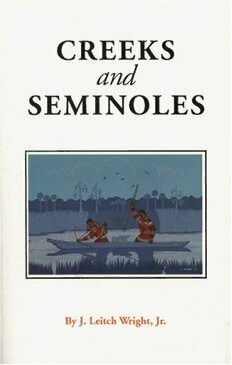
Creeks and Seminoles: The Destruction and Regeneration of the Muscogulge People PDF
Preview Creeks and Seminoles: The Destruction and Regeneration of the Muscogulge People
Page i Creeks and Seminoles Page ii Indians of the Southeast Page iii Creeks & Seminoles The Destruction and Regeneration of the Muscogulge People J. Leitch Wright, Jr. Page iv Copyright 1986 by the University of Nebraska Press All rights reserved Manufactured in the United States of America First paperback printing: 1990 Most recent printing indicated by the last digit below: 10 9 8 7 6 5 Library of Congress CataloginginPublication Data Wright, J. Leitch (James Leitch), 1929 Creeks and Seminoles. (Indians of the Southeast) Bibliography: p. Includes index. 1. Creek Indians—History. 2. Seminole Indians— History. 3. Indians of North America—Southern States— History. I. Title. II. Series. E99.c9w69 1986 975'.00497 8611281 ISBN 0803247389 (alk. paper) ISBN 0803297289 (pbk.) Page v In memory of Helen Lee Wright Bynum Page vii Contents List of Maps and Illustrations viii Series Editors' Introduction ix Preface xi 1 1 The Southeastern Muscogulges 2 41 Trade 3 73 The Black Muscogulges 4 101 Relations with Britain, Spain, & France 5 129 Manifest Destiny 6 155 The Creek War, 1813–15 7 185 Old Hickory and the Seminoles 8 217 Prelude to Removal 9 245 The Defiant Muscogulges, 1835–42 10 281 Dispersal and Survival List of Abbreviations 323 Notes 325 Bibliography 353 Index 369 Page viii Maps The Muscogulge Landscape 7 Muscogulge Settlements 13 White Settlements 220 Illustrations The Creek busk, or green corn ceremony 28 Seminole dance at Fort Butler, Florida 1838 39 Concepción 1792 52 Benjamin Hawkins's Creek agency 144 Timpoochee Barnard 170 Signing of the Treaty of Fort Jackson 178 Hillis Haya, selfportrait 195 Hillis Haya as portrayed by whites 196 Destruction of the Negro Fort 198 Milly Francis pleading for Duncan McKrimmon 201 Bowlegs Town 206 William Mcintosh 212 Neamathla 234 Seminole village 236 Luis Pacheco 257 Opothleyahola 269 Gopher John 276 Abraham 277 Sorrows of the Seminoles 302 Page ix Series Editors' Introduction For more than two centuries the Indians of the Southeast have fascinated writers and scholars. Since the 1770s, when William Bartram, a traveling naturalist, reported on the Creeks and Seminoles and lames Adair, a retired trader, published the first lengthy interpretation of Southeastern Indian history and culture, many books and essays have appeared that have attempted to explain these people and their histories. Some have dealt with the region as a whole, others have focused on a particular group. With few exceptions, however, this substantial literature on Southeastern Indian history has focused on political questions. How did an Indian nation respond to European and American diplomatic pressures? How did it deal with Andrew Jackson's removal policy of the 1830s? Less often, scholars have asked how the various Southeastern nations governed themselves or related to one another. But despite a shift in emphasis from the traditional "Indianwhite relations" themes to an analysis of internal issues, the political emphasis has remained. J. Leitch Wright, Jr., has broken out of this political preoccupation and offers here an interpretation of Creek and Seminole history that stresses ethnic factors. We have long known that the socalled Creek Confederacy was composed of a bewildering variety of autonomous groups that spoke many different languages and had many different cultural and historical experi Page x ences. Until now, however, no scholar has attempted to explain the historical implications of this ethnic diversity. Eschewing the traditional nomenclature of Creek and Seminole as too reflective of an artificial European political misperception, Wright uses the term Muscogulge, meaning Muskogee people. The Muscogulges, Wright argues, were divided into two broad groups based on language. The tensions between those groups best explain both their internal history and their relations with other Indian nations, Europeans, and Americans. Wright's interpretation does not ignore political problems; rather, he argues that ethnic differences of precontact origin account for the factionalism that so characterized eighteenthand nineteenthcentury Creek history and suggests that those conflicts were largely responsible for the establishment of a separate Seminole tribe in Florida. It is an arresting argument that challenges the traditional interpretations of Creek and Seminole history and raises significant questions about the nature of ethnicity in Native American societies. The series Indians of the Southeast, was created to "foster study of the internal dynamics" of Southeastern Native societies; we are pleased to offer Creeks and Seminoles: The Destruction and Regeneration of the Muscogulge People as the first volume. MICHAEL D. GREEN THEDA PERDUE
